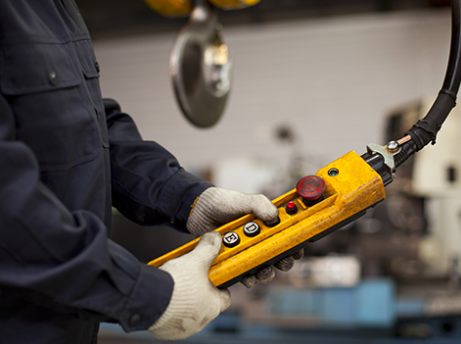This course covers overhead crane hazards, safety devices, pre-op inspection and testing, and procedures for load rigging and lifting. As well as, safe work practices for unattended equipment, working around others, and disconnecting power to equipment.
Overhead and Gantry Crane Safety
$24.15
Description
- Recognize the characteristics of overhead and gantry cranes
- Identify how to inspect a crane prior to use
- List required actions to prepare for a safe lift
- Describe how to safely lift, move and set down a load
The two most common types of industrial cranes are overhead and gantry. An overhead crane has a movable bridge that commonly carries a movable trolley supporting the hoisting mechanism, traveling on an overhead fixed runway structure.
A gantry crane is similar to an overhead crane except that the bridge for carrying the trolley or trolleys is rigidly supported on two or more legs. It runs on fixed rails or other similar runway, usually on the ground. Safety standards and operating procedures for overhead and gantry cranes are grouped together because they all have similar traveling and hoisting characteristics.
Here are the basic inspection and operation safety points for cranes:
Control Pendant Inspection
- Make sure wiring is properly connected to the pendant.
- Check for visible damage (wiring frayed or disconnected).
Load Hook and Safety Latch Inspection
- Ensure the safety latch properly closes across hook throat.
- Do not use a hook that has been stretched.
- Do not replace the safety latch of a stretched hook with a longer safety latch.
- Check for cracks, weld marks, bent shanks, or other signs of damage.
- Report any signs of damage to your immediate supervisor or foreman.
Load Bearing Rope Inspection
- Performed before any lifting.
- Crucial to safe lifting.
- Inspect for signs of wear and corrosion.
Ladder, Platform, Walkway, Inspection
- Ladders, stairways, and raised walkways need to be checked for damaged or missing parts
Even after a thorough inspection and pre-operation testing, overhead crane operation poses significant hazards unless the load is correctly balanced, rigged and secured. Load rigging procedures require following the rated load capacity of the sling, hook, and lifting devices, selecting the proper gear to rig with, determining correct sling angles where necessary, and protecting the sling against hazards.
Pre-Operation Check
- Begin with the operating controls. Each function must be tested, no matter how frequently or infrequently it is used.
- Operate the crane a few feet in each direction. Listen and look for any sound or movement that could indicate damage.
- Slowly raise the load block until it trips the upper limit switch.
- Check the emergency stop button to make certain it is working properly.
- Verify that the wire rope is spooling properly on the drum when the load is raised and lowered.
Operation Safety
- First, perform a below-the-hook device inspection. Check for damage of: spreader bars, shackles, pulleys, slings.
- Start the lift slowly to minimize swinging of the load. Make sure the rigging job is properly holding, and there is no slipping.
- Raise the load high enough to clear any obstacles in one smooth motion. Avoid any abrupt moves. Remember, overhead cranes are designed only for vertical lifts. If the load is pulled sideways, serious damage or catastrophic crane failure could result.
- Once the load is properly raised, you can move the load to the desired location. Never carry a load over the top of someone. When the crane is in position, slowly lower the load to its set-down point.
- Keep hands away from pinch points. Stop when the load block is low enough to unhook the sling.
- If the load is free-swinging and needs to be turned for placement, tag lines should be affixed to at least two corners of the load so that the load can be turned without standing under or close to it while adjusting its position by hand.
- If you have an emergency, shut off the main disconnect switch for the crane. Make sure you know the location of the main disconnect switch. If the type of crane you are operating does not have a disconnect box nearby, the stop button on the control pendant should cut off all power to the crane.
Required Safety Practices
- Never move a load over co-workers.
- Do not permit co-workers to walk underneath the load.
- Return the load block to its designated location after use.
- Do not leave the load block low enough for someone to run into.
- Never leave a suspended load unattended.
- Do not leave unused slings suspended on a crane hook where they could become snagged on passing equipment.
- If it has a designated storage area, move the crane to that location.
- Continuously observe equipment for any sign of problems during operation. Pay attention to what you are doing—don’t allow yourself to become careless or distracted.
Not all training is equal. With SafetyNow, learners and leaders will notice the difference in value:
- Quality: Professionally-researched and designed using the latest mobile and responsive technologies
- Convenience: Works instantly on any device, desktop or mobile
- Time savings: What learners need to know, not extra fluff or legalese
- Reporting: Consistent, instant compliance records available anytime
- Support: Customer and learner support included at no charge
- Any Learning Management System (LMS) Use with any SCORM, AICC, xAPI, TinCan, HTML5, or other LMS (learning management system).
- Any Device Desktop, laptop, tablet, or mobile phone – it simply works, everywhere.
- Engaging Professionally-developed, including an on-screen host and modern, easy-to-understand text, media, and voiceovers.
- Unlimited Attempts Each module can be taken as many times as required to get a passing grade. Unlike our competitor’s courses, if you get an answer wrong, you are redirected to the exact eLearning segment you struggled with… you don’t need to go through the entire module again, just the one part you need a refresher on.
Only logged in customers who have purchased this product may leave a review.












Reviews
There are no reviews yet.